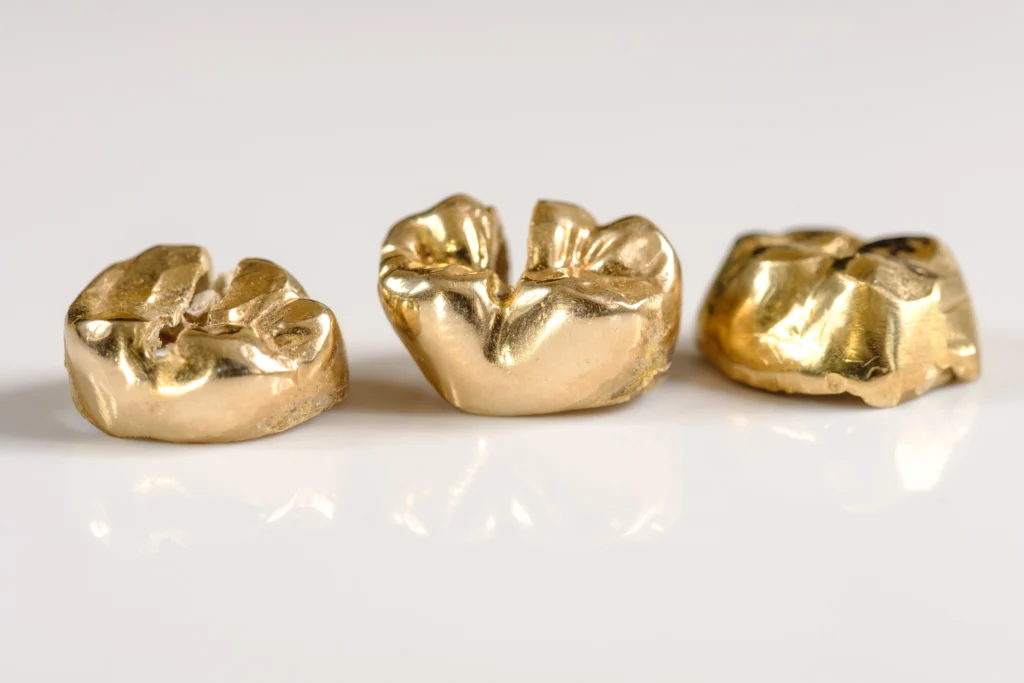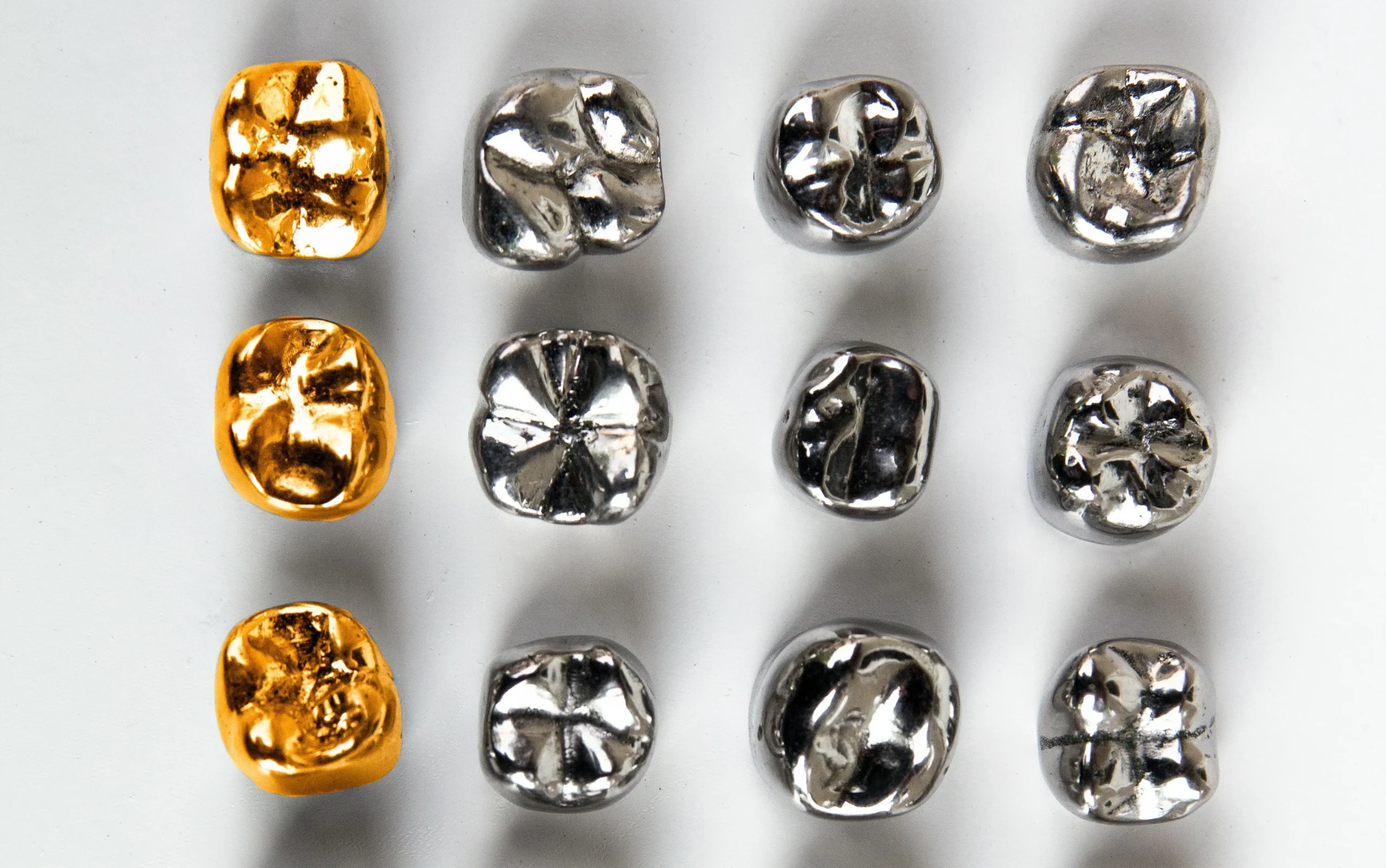The first thing that comes to mind when most people think of gold is usually jewelry, coins, or even investing. But, did you know that dental gold ranks among one of the most common uses of the beloved precious metal? Not only is dental gold relatively common, but it can be quite valuable.
Dental gold is used to make crowns, bridges, inlays and onlays, implants and other restorative materials to repair peoples’ smiles. Sometimes it’s even used for fun bedazzling purposes like tooth jewelry. Whether used medically or cosmetically, gold is a preferred material in dentistry because it’s extremely durable and biocompatible, making it ideal for a long-term stay inside the oral cavity.
Gold Dental Bridges and Implants
Precious metals are used in gold dental bridges, crowns, implants and more. But what functions do these items actually serve?
Even those who aren’t familiar with dental gold have probably heard of a gold crown. Crowns are a type of dental repair in which a tooth or multiple teeth are covered for protection, usually due to a weak or cracked tooth.
A gold dental bridge is a type of dental treatment that uses one or more artificial teeth, referred to as pontics, to replace missing teeth. Pontics are held in place by crowns that are placed on the neighboring teeth. Several components of dental bridges, including the pontics and the crowns that connect them, can be made from gold alloys, porcelain, or a combination of these materials.
Dental implants are essentially artificial tooth roots that are surgically attached to the jawbone. Over the course of a few months, the bone surrounding the implant grows, holding it firmly in place. Then replacement teeth are attached to the implant with a metal connector, which is often made of titanium. Although titanium is traditional, gold dental implants are also a viable option with high durability, and some people prefer the aesthetic appeal of gold.
What Karat is Dental Gold?
Bridges, implants and crowns are just a few examples of common dental repairs that use gold. But just how much gold do most dental treatments really contain?
The gold used in dentistry is never pure 24 karat gold, because pure gold is too soft and malleable to withstand the ongoing wear and tear of life in your mouth. Instead, to increase strength and durability, gold is alloyed with other metals such as platinum, palladium and/or silver.
The karat value of dental gold ranges widely depending on when and where the material was produced. For example, older dental crowns tend to contain more gold than the newer versions. Some gold crowns rank as high as 18 karats!
Keep in mind that not all gold-containing dental material is gold in color – sometimes white gold alloys are used as well. So don’t let silver crowns or implants fool you – they could still contain gold!

Is Dental Gold Still Common?
Is dental gold becoming a thing of the past? Yes and no. Dentists definitely still use gold, but not nearly as often as they did in previous decades. According to a Chicago Tribune article, until about 14 years ago, roughly 67 metric tons (nearly $3 billion worth at today’s prices!) of gold were used each year to make dental fillings, caps and crowns. Over the past 5-7 years, the demand for gold in dentistry has decreased nearly 60 percent.
Dental experts credit gold’s reduced demand to several factors, including trends towards whiter teeth and advancements in dental ceramics like porcelain crowns and composite resin fillings. Gold’s higher price also makes it a less economical option for dental work.
Why Do Dentists Still Use Gold?
With a range of new materials available for dental restorations, one might wonder why dentists still use gold at all. Although gold is the least natural-looking material for dental work, it still offers superior strength and durability. There are several key benefits to using gold in dental repairs over porcelain and other ceramic materials. Gold crowns and other dental implants can last up to 50 years with proper care, as much as 2-3 times longer than other materials! That’s a great way to avoid future time in the dentist chair.
First of all, gold alloys hold up best against the forces of chewing, biting and grinding. Gold is flexible yet strong enough to withstand even the heaviest human bite without chipping or cracking. This is pretty impressive, considering that the average human bite strength is about 162 pounds per square inch, and the world record for the strongest bite is 975 pounds!
Furthermore, gold alloys don’t wear down the opposing teeth, which is especially important for people who grind their teeth. Dental gold is also chemically stable and exceptionally resistant to acidity, bacteria, oxidation and corrosion. It’s compatible with human tissue like the gums, so it won’t cause any adverse reactions inside the body.
Last but not least, gold is very malleable. It can easily be formed and fitted precisely around or in place of a tooth without leaving any gaps.
Gold vs Alternative Materials

Despite gold’s functional benefits, many patients prefer other materials for aesthetic reasons. Porcelain and ceramic crowns can match the rest of one’s smile almost perfectly, offering a more natural appearance.
But depending on where dental work is being done inside the mouth, gold may make more sense than other non-metal materials in some cases. For example, a molar that isn’t visible when you smile doesn’t necessarily need the most natural-looking crown or filling. Instead, it’s ideal to use the strongest material possible, because the molar area withstands the most pressure from chewing and biting. In this scenario, a gold alloy would likely be the most practical choice, as it would last the longest.
All in all, gold is still preferred in clinical cases where strength, durability and biocompatibility are most important. Although it’s become less and less common throughout the years, it’s unlikely that gold will ever completely disappear from the world of dentistry.
Selling Dental Gold
Dental gold is a valuable asset that should be kept out of landfills. Not only does mining this material have substantial environmental impacts, but old dental material may contain other deleterious materials better suited for recycling. Whether it’s a crown, bridge, implant or any other type of dental material, the precious metal inside can be extracted, refined and repurposed for another use. There are many options when it comes to businesses that will buy dental gold, but refineries like Garfield who specialize in dental refining will provide the most accurate assessments of the material, and most importantly, the highest payouts.
If you ever end up with unwanted dental gold on your hands, you can cash in by shipping it to Garfield Refining. Garfield has been recognized as ‘North America’s Best Dental Refiner’ for thirteen years straight, thanks to our high payouts and exceptional customer service. We accept all forms of dental scrap, including crowns, bridges, PFMs, inlays and onlays, partial dentures and dental implants. If you’re looking to reduce waste and monetize your dental gold, look no further than Garfield!
Consider getting cash for gold or silver and selling your precious metal scrap now by starting your shipment today.
Established in 1892, we have more than a century of experience in refining precious metals. We serve various industries, including dental offices, private individuals, jewelers, pawnbrokers, and more!

